Some chronograph watches are automatic, and some use quartz movements. Ticking is a term used in quartz watches. The two types of movements in the watchmaking industry are quartz and mechanical; automatic watches are mechanical. Watches either sweep or tick, with sweeping being a term used with mechanical watches.
Almost all watches that ‘sweep’ also ‘tick ‘. There is no actual definition of when ticking becomes sweeping. The sweeping of a chronograph watch hand may appear like a continuous movement to the human eye. However, the movement is merely ticking rapidly.
Ticking is usually considered one movement per second; in quartz watches, this is common. Quartz watches can tick more often per second, known as high-frequency quartz. High-frequency quartz leads to more drain on the battery.
What Is A Chronograph?
A chronograph is an additional stopwatch function of a watch. In a mechanical watch, it’s known as a complication. Many chronographs have additional measurement scales, such as a tachymeter, pulsometer, and telemeter. The tachymeter is a different scale for calculating speed.
Apart from tachymeters, chronographs can have features such as telemeters and, less frequently, pulsometers. Doctors use pulsometers to determine a patient’s pulse. A telemeter scale will calculate distances.
The chronograph function is one-push to start and stop the process and another to reset back to zero. Usually, there are two push buttons on the watch case’s right side. One button is at 2 o’clock, and this is for the stopping and starting functions. The other button, at 4 o’clock, is the reset function.
The Origin Of The Ticking Sound
The ticking sound in a watch originates from the escapement. The escapement links the energy released by the mainspring and the balance spring. The balance is also responsible for a watch’s precision. The balance wheel swings and releases a tooth of the escapement escape wheel gear, which advances or ‘escapes’ by a fixed amount.
In a mechanical watch, the wheels move with every swing of the balance wheel; this causes the ticking. They tick when the power source moves the components forward. The escape wheel tooth hitting the face of the entry or exit pallet stone on the escapement makes a ticking sound. The number of ticks per second affects the seconds (or minute) hand’s movement.
Ticking Vs. Sweeping
Typically when a watch ticks, it is mechanical (either manual or automatic). However, a watch will have a mechanical movement if it is sweeping rather than ticking. Some automatic watches tick just like a quartz watch, but 99 % of automatic watches have sweeping hands.
Automatic watches that tick have extremely complicated movements and are expensive (Upwards of $10,000). A ticking automatic and mechanical watch doesn’t serve much purpose and are aesthetic features; it’s rare to find these types of watches.
The distinction between sweeping and ticking is in frequency. Hertz (Hz) and vibrations per hour (VpH) are terms used to measure a watch’s frequency. Hertz refers to the number of oscillations the balance wheel in a watch’s movement makes in a single second. Half an oscillation, the swing of the wheel in either direction equates to one vibration. Each vibration equals one tick.
Early wristwatches had a much slower ticking speed of 18,000 VpH, equating to only five ticks per second (8,000 / 60 / 60 = 5 or 2.5 Hz). In the 20th century, a wristwatch’s ‘normal’ ticking frequency was 21,600 VpH. A watch with a 21,600 VpH is ‘ticking’ six times per second, equivalent to 21,600 /60 /60 =6 or 3 Hz
High-frequency movements became popular in the 70s. An operating frequency of 28,800 VpH is regarded as high and equates to eight ticks per second, or 28,800 / 60 / 60 = 8 or 4 Hz. In 2020, high frequency is defined as more than 36,000 VpH, which equates to ten ticks per second (36,000 / 60 / 60 = 10 or 5 Hz).
Quartz watches are much more precise than any mechanical watch because the quartz crystal vibrates at 32,768 Hz. However, watchmakers continue to push the boundaries of convention with mechanical watches that run at high frequencies to show off their craftsmanship.
Most high-end mechanical watches run at 10 Hz or more frequency and measure time to 1/20th of a second. The Breguet Classique Chronométrie 7727 runs at 10 Hz, which is 72,000 VpH. This watch can set you back $40,000. It is a marvel of craftsmanship that requires water-resistant silicon in the movement rather than metal.

The Quartz Movement
A Quartz movement powers a ticking watch. Quartz replaced mechanical movements in the early 70s. Although quartz movements are accurate and don’t need much maintenance except to replace the battery, most are cheap and not as desirable to watch collectors.
The Quartz movement, powered by a battery, sends electric currents through a small Quartz crystal, creating oscillations. The oscillations generate regular electric pulses of one per second. This pulse drives a small electric motor, which turns the gears, spinning the watch’s second hand at one tick per second.
Sweeping Watches
Compared to a quartz movement, Sweeping-motion watches are manual and have mechanical movements. These watches are usually collector’s items, are mechanically outstanding, and look impressive. They have no internal circuit, electric motor, or battery; the user must wind the watch to store energy. The energy disappears through gears and springs. Gears and springs regulate the energy release speed.
Energy is transferred at around 21,600 beats per hour, equating to six beats per second. As a result, the second-hand sweep smoothly around the dial instead of ticking. Watches that sweep have a more precise way of telling the time down to a split second.
Types Of Chronographs
The simple or standard chronograph has at least one push button (known as a pusher) that allows the stopwatch to start, stop, and be reset. Early chronographs only had one push button. The first chronograph with two push buttons appeared in 1923.
The flyback and rattrapante chronographs offer different benefits. The flyback, designed for military aviation, allows the stopwatch to be set back to zero with a press of the second push button without stopping the ongoing measurement.
Rattrapante’s are split-second or double chronographs. Often found at race circuits, rattrapante’s measure intervals. Rattrapante, a French word meaning ‘to catch up, is an extra stopwatch second hand to measure intervals.
Meca-quartz movements tick (for the time) and sweep (for the chronograph). These watches are hybrids with a combination of mechanical and quartz movements. The Seiko caliber VH31, a 3-hander Meca-quartz caliber with a central-sweeping seconds hand, is an excellent example of a hybrid watch.
Conclusion
The chronograph has been around since 1816; it can be mechanical or quartz. Chronographs either tick or sweep. Sweeping is another way of saying ticking at high speed, so chronographs that sweep also tick.
References
- https://www.timeandwatches.com/p/the-detent-escapement-from-marine.html
- https://www.fratellowatches.com/you-asked-us-which-watches-sweep/#gref
- https://www.allinwatches.com/quartz-or-automatic-watch-a-tough-choice-made-easy/
- https://chronometercheck.com/sweeping-second-hand-watches/
- https://www.chrono24.co.za/magazine/what-is-a-chronograph-and-how-does-it-work-p_33269/







